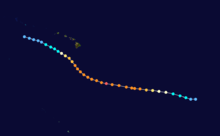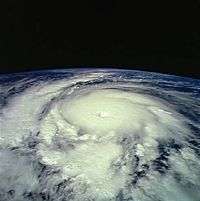Hurricane Emilia (1994)
| Category 5 major hurricane (SSHWS/NWS) | |
 Hurricane Emilia near peak intensity on July 19 | |
| Formed | July 16, 1994 |
|---|---|
| Dissipated | July 25, 1994 |
| Highest winds |
1-minute sustained: 160 mph (260 km/h) |
| Lowest pressure | 926 mbar (hPa); 27.34 inHg |
| Fatalities | None |
| Damage | Minimal |
| Areas affected | Hawaii |
| Part of the 1994 Pacific hurricane season | |
Hurricane Emilia was, at the time, the strongest tropical cyclone on record in the Central Pacific Ocean, and the first of such to be classified as a Category 5 hurricane – the highest rating on the Saffir–Simpson hurricane wind scale. However, hurricanes Gilma later that year and Ioke in 2006 later reached lower barometric pressures in the Central Pacific. The fifth named storm and the first of three Category 5 hurricanes of the 1994 hurricane season, Emilia developed from an area of low pressure southeast of Hawaii on July 16. Tracking westward, the initial tropical depression intensified into a tropical storm several hours after tropical cyclogenesis. Subsequently, Emilia entered the Central Pacific Ocean and moved into the area of responsibility of the Central Pacific Hurricane Center (CPHC).
After reaching hurricane intensity the following day, the tropical cyclone began to rapidly intensify, and late on July 19, Emilia reached its record peak intensity with maximum sustained winds of 160 mph (260 km/h) and a minimum barometric pressure of 926 mbar (hPa; 27.34 inHg), rating it as a Category 5 hurricane. After slight oscillations in strength, an upper-level trough forced the intense hurricane northwest on July 21, and Emilia began to weaken thereafter. The tropical cyclone encountered an area of vertical wind shear and cool sea surface temperatures, which further weakened the system. The following day, Emilia made its closest approach to the Big Island of Hawaii, but subsequently weakened to below hurricane intensity. This weakening trend continued, and the tropical cyclone fully dissipated on July 25. Though the hurricane did not make landfall, Emilia brought strong surf to the islands of Hawaii and caused gusty winds, which resulted in some property damage. Precipitation was also reported, but remained under moderate levels.
Meteorological history

On June 29, a weak tropical wave exited the west African coast and traversed the Atlantic, showing no signs of organization or convective activity. Moving within the Intertropical Convergence Zone, the tropical disturbance remained inactive until July 14, when it developed into an area of low pressure roughly 2,110 mi (3,400 km) east-southeast of the Hawaiian Islands. A low-level circulation became evident, and the system was designated as a tropical depression on July 16. Within 12 hours, satellite imagery suggested that the system had intensified into Tropical Storm Emilia with 40 mph (64 km/h) sustained winds.[1][2] Emilia steadily intensified into a minimal hurricane by the next morning, as it moved west-northwest.[2] At 18:00 UTC, Emilia was upgraded to Category 2 status as it crossed 140°W and entered the Central Pacific Hurricane Center's (CPHC) area of responsibility, which noted that Emilia was "well developed."[3] Emilia then proceeded to rapidly intensify, with maximum sustained winds increasing from 105 to 160 mph (169 to 257 km/h) over the next 48 hours.[2][3] At Emilia's peak strength, an Air Force reconnaissance aircraft measured a minimum central pressure of 926 mbar (27.34 inHg), the lowest pressure ever recorded in a Central Pacific hurricane at that time.[4][nb 1]

On July 20, Emilia briefly weakened into a Category 4 hurricane, but it was re-upgraded to Category 5 status by the CPHC 12 hours later during the day.[3] Subsequently, Emilia began to weaken for the final time. An upper-level trough in the westerlies caused the cyclone to turn northwest on July 21.[3][4] Emilia moved over progressively cooler waters, and vertical wind shear from the westerlies negatively impacted the hurricane.[3] The central pressure steadily rose to 965 mbar (28.50 inHg), and Emilia diminished into a marginal Category 3 hurricane.[3] On July 22, Emilia continued to weaken, and it passed within 170 mi (270 km) of the Big Island.[4] It was the closest approach to the islands.[4] Later, Emilia's peak winds dropped to 75 mph (121 km/h).[3] Emilia gradually turned west-northwest, and the circulation moved with the trade winds.[4] Emilia weakened into a tropical depression on July 24,[3] and a remnant swirl of stratocumulus clouds was noted.[4] The system dissipated on the same day.[3][5]
Preparations
Initially, forecasts significantly underestimated the intensification of Emilia,[1] which was one of three tropical cyclones to attain Category 5 status in the central Pacific during the season.[3] On July 16, a 72-hour forecast misjudged the strengthening of Emilia by 41 m/s (92 mph).[1] Later, winds at 72 hours were 31 m/s (69 mph) too high when the cyclone began to weaken.[1] Tropical cyclone forecast models consistently predicted Emilia to remain south of the Hawaiian Islands because of the upper troughs' climatologically weak nature during the summer.[6] This led to high confidence in the forecasts,[7] resulting in a lack of watches or warnings.[3] Nonetheless, a high surf advisory was issued for the south and east coasts of all islands.[8]
Impact and records
Despite the storm's offshore nature, wells of 6–10 feet (1.8–3.0 metres) were reported near the Puna and Ka‘ū coasts.[9] Waikiki Beach in Honolulu reported a 5 ft (1.5 m) high surf. Surf was lower along the Kona and Kohala coasts.[3][10] Winds were gusty, causing a few trees to be blown over and branches to be broken. Some minor roof damage was caused by the winds.[3] International observatories and the Keck Telescope on the top of Mauna Kea were forced to close their domes due to the high winds.[11] Rainfall ranged from light to moderate. The storm passed near two National Oceanic and Atmospheric Administration (NOAA) weather buoys during its passage through the state. All in all, Hurricane Emilia had mostly minor effects in the Hawaiian Islands.[3]
Emilia is one of the most intense tropical cyclones on record in the Eastern Pacific, with a minimum pressure of 926 mbar (hPa; 27.34 inHg). In the CPHC warning zone, only Gilma and Ioke of 2006 attained deeper pressures.[2] Emilia was also a Category 5 hurricane for 18 hours, the most ever at the time in the Central Pacific. That record was broken later in the season by Hurricane John.[12]
The storm was the subject of a disagreement between the Central Pacific Hurricane Center and the National Hurricane Center. Specifically, they debated Emilia's peak strength in relation to the Saffir-Simpson hurricane scale (SSHWS). The CPHC reported that Emilia's maximum winds peaked at 140 knots (260 km/h), making it a Category 5 hurricane.[3] However, the NHC considered Emilia to be a high-end Category 4 with maximum winds of 135 knots (250 km/h), in both its "best track"[13] and its preliminary report.[14] During 2008, the NHC upgraded its "best track" to make Emilia a Category 5, although there continues to be a discrepancy in Emilia's duration at Category 5 intensity. The CPHC's data deems Emilia as having regained Category 5 status at 18:00 UTC July 20 and maintaining it for 12 hours, while the NHC's data places Emilia as having maintained Category 4-strength winds of 155 mph (249 km/h) during this period.[2][3]
See also
| Wikimedia Commons has media related to Hurricane Emilia (1994). |
- Hurricane Ignacio (1985)
- Hurricane Gilma (1994)
- List of Hawaii hurricanes
- Pacific hurricane
- List of tropical cyclones
Notes
- ↑ The Central Pacific Hurricane Center (CPHC) lists Emilia as a Category 5 cyclone, but the National Hurricane Center (NHC) classified Emilia as a strong Category 4 hurricane with 155 mph (249 km/h) sustained winds. However, in 2008, the NHC upgraded the storm into a Category 5 hurricane for 6 hours.[2]
References
- 1 2 3 4 Mayfield, Max; Pasch, Richard J. (1996). "Eastern North Pacific Hurricane Season of 1994" (PDF). Monthly Weather Review. NOAA. 124 (7): 1579. Bibcode:1996MWRv..124.1579P. doi:10.1175/1520-0493(1996)124<1579:ENPHSO>2.0.CO;2. Retrieved 2008-02-20.
- 1 2 3 4 5 6 National Hurricane Center; Hurricane Research Division; Central Pacific Hurricane Center. "The Northeast and North Central Pacific hurricane database 1949–2016". United States National Oceanic and Atmospheric Administration's National Weather Service. A guide on how to read the database is available here.
- 1 2 3 4 5 6 7 8 9 10 11 12 13 14 15 16 Central Pacific Hurricane Center (1994). "The 1994 Central Pacific Tropical Cyclone Season". NOAA. Retrieved 2008-02-20.
- 1 2 3 4 5 6 Lawrence, Miles (1994). "Hurricane Emilia July 16–25, 1994". NOAA. Retrieved 2008-02-22.
- ↑ Blake, Eric S; Gibney, Ethan J; Brown, Daniel P; Mainelli, Michelle; Franklin, James L; Kimberlain, Todd B; Hammer, Gregory R (2009). Tropical Cyclones of the Eastern North Pacific Basin, 1949-2006 (PDF). Archived from the original on July 28, 2013. Retrieved June 14, 2013.
- ↑ "Hurricane Emilia Discussion Number 11". Central Pacific Hurricane Center. Retrieved 2008-02-23.
- ↑ "Hurricane Emilia Discussion Number 13". Central Pacific Hurricane Center. Retrieved 2008-02-23.
- ↑ Larry W. Tarleton (1994-07-21). "Hurricane may pass Hawaii". Associated Press. Retrieved 2013-07-09.
- ↑ Lawrence, Miles (1994). "Hurricane Emilia Preliminary Report (Page 2)". NOAA. Retrieved 2008-02-23.
- ↑ Larry W. Tarleton (1994-07-22). "Hurricane Emilia Skirts Hawaiian Islands". Associated Press. Retrieved 2013-07-09.
- ↑ Malcolm W. Browne (1994-07-23). "Fiery comet concludes spectacular displays". New York Times. Retrieved 2013-07-09.
- ↑ "8. What hurricanes have been at Category Five status the longest?". Central Pacific Hurricane Center. Retrieved 2008-02-23.
- ↑ "EMILIA Tracking information". Unisys. Archived from the original on 2007-08-06. Retrieved 2008-11-01.
- ↑ Lawrence, Miles (1994). "Hurricane Emilia Preliminary Report (Page 3)". NOAA. Retrieved 2008-02-23.
